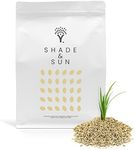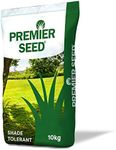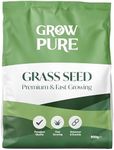Buying Guide for the Best Shade Grass Seeds
Choosing the right shade grass seeds is crucial for ensuring a lush, green lawn in areas that receive limited sunlight. Shade grass seeds are specifically designed to thrive in low-light conditions, making them ideal for gardens with lots of trees or buildings that block sunlight. When selecting shade grass seeds, it's important to consider factors such as the type of shade, climate, and the intended use of the lawn. Understanding these factors will help you select the best grass seed variety for your specific needs, ensuring a healthy and vibrant lawn.Shade ToleranceShade tolerance refers to the grass seed's ability to grow in areas with limited sunlight. This is important because not all grass types can thrive in shaded areas. Shade tolerance is typically categorized into full shade, partial shade, and light shade. Full shade seeds are best for areas that receive very little direct sunlight, while partial shade seeds are suitable for areas with filtered sunlight. Light shade seeds can handle more sun but still perform well in shaded conditions. To choose the right one, assess the amount of sunlight your lawn receives throughout the day and select a seed with the appropriate shade tolerance.
Grass TypeDifferent grass types have varying levels of shade tolerance and growth characteristics. Common shade-tolerant grass types include fescues, ryegrass, and certain bluegrasses. Fescues are known for their fine texture and ability to thrive in dense shade, making them a popular choice for heavily shaded areas. Ryegrass is more suitable for areas with moderate shade and is known for its quick germination. Bluegrasses can handle light to moderate shade and are often chosen for their lush appearance. Consider the specific conditions of your lawn and choose a grass type that matches your shade and aesthetic preferences.
Climate AdaptabilityClimate adaptability refers to how well a grass seed can grow in your local climate conditions. This is important because some grass types are better suited for cooler climates, while others thrive in warmer regions. Cool-season grasses, like fescues and bluegrasses, are ideal for regions with cold winters and mild summers. Warm-season grasses, such as certain ryegrasses, perform better in areas with hot summers and mild winters. To select the right seed, consider your local climate and choose a grass type that is known to perform well in those conditions.
Lawn UsageLawn usage refers to how you plan to use your lawn, which can influence the type of grass seed you choose. This is important because some grass types are more durable and can withstand heavy foot traffic, while others are more delicate and better suited for ornamental purposes. If your lawn will be used frequently for activities like playing or entertaining, choose a grass seed known for its durability and wear resistance. For lawns that are primarily for aesthetic purposes, you might prioritize grass types with a finer texture and lush appearance. Consider your intended use and select a grass seed that aligns with those needs.
Seed MixA seed mix is a combination of different grass types blended to provide a balanced lawn that can handle various conditions. This is important because a mix can offer the benefits of multiple grass types, such as shade tolerance, durability, and aesthetic appeal. Seed mixes are often categorized by their intended use, such as shade mixes, sun and shade mixes, or high-traffic mixes. To choose the right seed mix, consider the specific conditions of your lawn, including shade levels, climate, and usage, and select a mix that addresses all these factors for a well-rounded lawn.
















